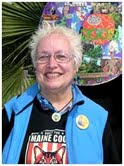
My first brush with raw and authentic fairy tales took place nearly thirty years when I was teaching English to Japanese children in Munich, Germany, where I lived from 1989 – 2000.
Intending to stock up on children’s literature, I discovered the a whole section of the Munich City Library was devoted to fairy tales from different cultures. It contained literally thousands of volumes, some of them ornate and leather-bound, as beautiful to hold as they were to read. I loved the Russian fairy tales the best, for they were the most haunting and evocative for me.
The fairy tales held me in thrall and would not let me go. They got under my skin and rooted themselves in my writing and my life. I was hooked.
Fairy tales are the domain of women. In past centuries, the traditional European storytellers were women sitting at their hearths and spinning at their spinning wheels–spinning a yarn, if you will. Telling old wives’ tales.
The original fairy tales were not romantic children’s stories. Only very recently with Walt Disney have these raw and very ominous stories been reduced to little more than cute cartoons. Until the 17th century, fairy tales were adult entertainment, the way of passing a dark winter’s evening. Many older fairy tales are quite bawdy. Allocation of fairy tales to the nursery took place in the 18th century when the educated upper classes rejected the irrational and supernatural aspects of the tales in favor of a more rational and scientific world view, thus dismissing these tales as nonsense and only good for amusing young children.
Yet, as the enduring popularity of Clarissa Pinkola Estes’ Women Who Run with the Wolves attests, fairy tales are meaningful and relevant for contemporary women seeking deep guiding archetypes and images of female strength.
These centuries-old stories bristle with wild and sometimes terrifying women who possess amazing powers. The witches and sorceresses who inhabit the dark forests of fairy tales offer a stark and startling contrast to the innocent maiden protagonists.
What I find most fascinating about fairy tales is not the young girl’s encounter with the prince, but with the witch. Baba Yaga in the Russian tradition and Frau Holle in the German tradition are both sorceresses of intimidating dimensions.
Baba Yaga eats human flesh and flies around in a cauldron. Her house dances on hen’s feet. Frau Holle lives in a house in a beautiful underground meadow and she showers young girls with either pure gold or filth, depending on how they have served her.
Both these figures are ancient archetypes of female sovereignty that had their origins as pagan goddesses. Baba Yaga was once a great mother goddess of the Slavonic peoples. According to ethnographer Sonja Ruettner-Cova, Frau Holle was originally a solar goddess and a weather goddess. When she shook out her featherbed, it snowed.
Ironically Baba Yaga and Frau Holle have lived on in fairy tales even after the old myths and religions that honored them were banished, precisely because fairy tales have been dismissed as children’s stories. The tales’ deep magic lies hidden in their deceptive simplicity.
The naive young girl must go into the woods on the darkest night to face Baba Yaga. She must leap down a well to find her way to Frau Holle’s house and serve her for a year and a day. Once the young heroine encounters the sorceress, she will be completely and utterly transformed–a girl no longer but a woman with secret powers of her own.
Fairy tales are full of images of women who both challenge and empower other women.
The culmination of the heroine’s journey a deep inner rootedness. It is finding and claiming that house in the forest deep in your soul.
Mary Sharratt is on a mission to write women back into history. Her most recent novel Ecstasy is about the composer Alma Schindler Mahler. If you enjoyed this article, sign up for Mary’s newsletter or visit her website.
 Just a few months ago, not long after turning seventy, I was diagnosed with mild osteoporosis. I had thought that all my yoga, my occasional forays to the gym, my daily walking, my frequently consumed leafy greens and yogurt , my calcium supplements would protect me. I had thought I was different from most other women my age, that I could avoid taking the medication that I knew was sometimes problematic. But the bone density scan revealed what I had feared, and because both of my parents declined and died shortly after hip fractures, because I had once broken an ankle, I decided to accept my doctor’s sober recommendation: that I begin a weekly dose of alendronate. It would be the first chronic medication I would ever be prescribed.
Just a few months ago, not long after turning seventy, I was diagnosed with mild osteoporosis. I had thought that all my yoga, my occasional forays to the gym, my daily walking, my frequently consumed leafy greens and yogurt , my calcium supplements would protect me. I had thought I was different from most other women my age, that I could avoid taking the medication that I knew was sometimes problematic. But the bone density scan revealed what I had feared, and because both of my parents declined and died shortly after hip fractures, because I had once broken an ankle, I decided to accept my doctor’s sober recommendation: that I begin a weekly dose of alendronate. It would be the first chronic medication I would ever be prescribed.


